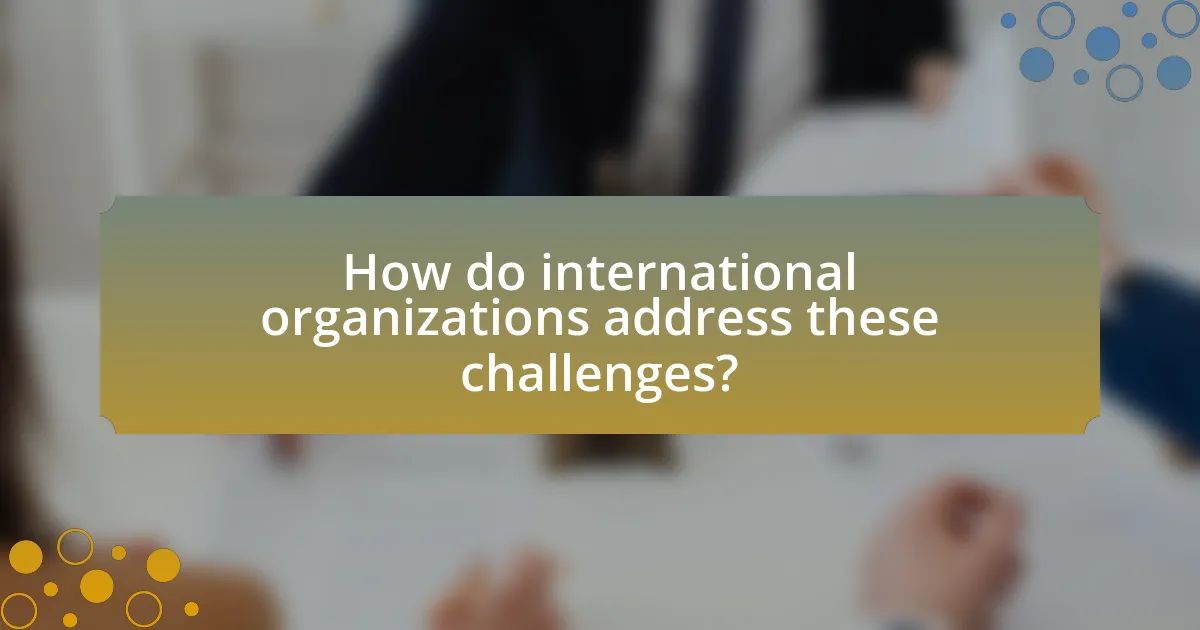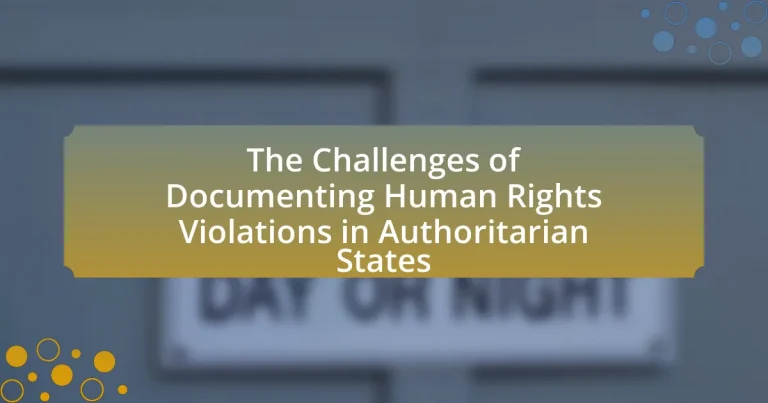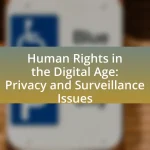The article examines the significant challenges faced in documenting human rights violations in authoritarian states, highlighting issues such as government repression, restricted access to information, and the pervasive fear of retaliation against witnesses. It discusses the methods employed by authoritarian regimes to suppress information, including censorship and surveillance, and the impact of these tactics on evidence gathering. The role of technology in enhancing documentation efforts is explored, alongside the risks associated with its use in oppressive environments. Additionally, the article outlines the strategies employed by international organizations and NGOs to address these challenges, emphasizing the importance of collaboration and adherence to legal frameworks in promoting accountability for human rights abuses.

What are the main challenges of documenting human rights violations in authoritarian states?
The main challenges of documenting human rights violations in authoritarian states include government repression, lack of access to information, and fear of retaliation against witnesses. Government repression often manifests through censorship, intimidation, and violence against activists and journalists, making it difficult to gather credible evidence. The lack of access to information is exacerbated by state control over media and communication channels, which limits the ability to report on abuses. Additionally, fear of retaliation discourages victims and witnesses from coming forward, as they may face imprisonment, torture, or worse. These factors collectively hinder the accurate documentation and reporting of human rights violations in such regimes.
Why is it difficult to gather evidence in authoritarian regimes?
Gathering evidence in authoritarian regimes is difficult due to state control over information and suppression of dissent. Authoritarian governments often restrict access to independent media, limit freedom of expression, and intimidate or imprison those who attempt to document human rights violations. For instance, organizations like Human Rights Watch report that in countries such as North Korea and China, the government actively censors information and punishes whistleblowers, making it nearly impossible for external observers to obtain reliable evidence. Additionally, the fear of retaliation discourages witnesses from coming forward, further complicating the collection of credible evidence.
What methods do authoritarian states use to suppress information?
Authoritarian states use censorship, propaganda, and surveillance to suppress information. Censorship involves controlling media outlets, blocking websites, and restricting access to foreign news sources, as seen in countries like China, where the Great Firewall limits online information. Propaganda is employed to disseminate state-approved narratives while discrediting dissenting views, exemplified by North Korea’s state-run media that glorifies the regime. Surveillance technologies are utilized to monitor citizens’ communications and activities, enabling governments to identify and punish those who share or access prohibited information, as evidenced by the extensive use of digital surveillance in countries like Iran.
How does fear of retaliation affect witnesses and victims?
Fear of retaliation significantly deters witnesses and victims from reporting human rights violations. This fear often stems from the potential for violence, harassment, or legal repercussions from authorities or perpetrators. Research indicates that in authoritarian states, where the rule of law is weak, the likelihood of retaliation increases, leading to underreporting of abuses. For instance, a study by the United Nations Office on Drugs and Crime found that fear of reprisals can lead to a 70% decrease in the willingness of individuals to testify against human rights violations. This reluctance not only hampers the documentation of abuses but also perpetuates a culture of impunity, allowing violations to continue unchecked.
What role does technology play in documenting violations?
Technology plays a crucial role in documenting violations by providing tools for evidence collection, verification, and dissemination. Digital platforms enable individuals and organizations to capture incidents through video, photographs, and audio recordings, which can serve as critical evidence in human rights investigations. For instance, the use of smartphones has increased the ability to document abuses in real-time, allowing for immediate reporting and sharing on social media, which can raise awareness and mobilize international responses. Additionally, technologies such as satellite imagery and data analytics help corroborate reports of violations by providing objective evidence of events and conditions on the ground. These advancements enhance the credibility of documentation efforts, as seen in various reports by organizations like Human Rights Watch and Amnesty International, which utilize technology to substantiate claims of abuses in authoritarian regimes.
How can digital tools enhance evidence collection?
Digital tools enhance evidence collection by enabling efficient data gathering, storage, and analysis, which is crucial in documenting human rights violations in authoritarian states. These tools, such as mobile applications, secure cloud storage, and data visualization software, allow for real-time documentation of incidents, ensuring that evidence is captured promptly and accurately. For instance, the use of encrypted messaging apps can facilitate secure communication among witnesses and activists, reducing the risk of interception by oppressive regimes. Additionally, platforms like Ushahidi have been employed to crowdsource reports of human rights abuses, providing a comprehensive and verifiable database of incidents. This technological integration not only improves the reliability of evidence but also aids in presenting it effectively to international bodies, thereby increasing accountability for violations.
What are the risks associated with using technology in oppressive environments?
Using technology in oppressive environments poses significant risks, including surveillance, data breaches, and repression of dissent. In authoritarian states, governments often employ advanced surveillance technologies to monitor citizens’ online activities, leading to potential arrests or harassment for those who express dissenting views. For instance, reports indicate that regimes in countries like China utilize facial recognition and internet monitoring to suppress opposition, creating a climate of fear that stifles free expression. Additionally, the use of encrypted communication tools can be compromised, as oppressive regimes may employ hacking techniques to access sensitive information, further endangering activists and whistleblowers. These risks highlight the precarious balance between leveraging technology for advocacy and the potential repercussions in environments hostile to human rights.

How do international organizations address these challenges?
International organizations address the challenges of documenting human rights violations in authoritarian states by employing various strategies, including advocacy, monitoring, and reporting mechanisms. For instance, organizations like Amnesty International and Human Rights Watch utilize satellite imagery and testimonies from defectors to corroborate evidence of abuses, thereby enhancing the credibility of their reports. Additionally, they engage in diplomatic pressure, urging governments to uphold human rights standards, and collaborate with local NGOs to gather information on the ground. These approaches are supported by historical data showing that sustained international attention can lead to improvements in human rights conditions, as seen in countries where global advocacy has prompted policy changes.
What strategies do NGOs employ to document human rights abuses?
NGOs employ various strategies to document human rights abuses, including witness testimonies, data collection, and collaboration with local organizations. Witness testimonies provide firsthand accounts of abuses, which are often recorded through interviews and surveys, ensuring that individual experiences are captured accurately. Data collection involves gathering quantitative information, such as statistics on arrests or casualties, which can be analyzed to identify patterns of abuse. Collaboration with local organizations enhances credibility and access to information, as these groups often have deeper insights into the local context and can facilitate outreach to affected communities. These strategies are essential for creating comprehensive reports that can be used for advocacy and legal action against perpetrators of human rights violations.
How do NGOs ensure the safety of their informants?
NGOs ensure the safety of their informants through a combination of anonymity, secure communication methods, and risk assessment protocols. By anonymizing informants’ identities, NGOs protect them from potential retaliation. Secure communication channels, such as encrypted messaging apps, minimize the risk of interception by hostile entities. Additionally, NGOs conduct thorough risk assessments to evaluate the potential dangers informants may face, allowing them to implement tailored safety measures. These practices are essential in environments where human rights violations are prevalent, as they help mitigate the risks associated with exposing sensitive information.
What partnerships are crucial for effective documentation?
Crucial partnerships for effective documentation of human rights violations in authoritarian states include collaborations between local NGOs, international human rights organizations, and academic institutions. Local NGOs provide on-the-ground insights and access to affected communities, while international organizations offer resources, advocacy, and a broader platform for visibility. Academic institutions contribute research expertise and methodologies for rigorous documentation. For instance, the partnership between Human Rights Watch and local activists has led to comprehensive reports that have influenced international policy. Such collaborations enhance credibility, ensure thorough documentation, and amplify the voices of victims.
How do international laws impact documentation efforts?
International laws significantly influence documentation efforts by establishing standards and frameworks that guide the collection and validation of evidence related to human rights violations. These laws, such as the Universal Declaration of Human Rights and various treaties, provide a legal basis for documenting abuses and hold states accountable for their actions. For instance, the International Criminal Court’s Rome Statute outlines the criteria for prosecuting war crimes and crimes against humanity, thereby encouraging organizations to document violations meticulously to support potential legal actions. Furthermore, adherence to international laws enhances the credibility of documentation efforts, as compliance with recognized standards can lead to greater acceptance of the findings by the global community and can facilitate advocacy for victims.
What legal frameworks exist to protect human rights defenders?
Legal frameworks that exist to protect human rights defenders include international treaties, regional agreements, and national laws. The United Nations Declaration on Human Rights Defenders, adopted in 1998, specifically outlines the rights and protections afforded to individuals who promote and protect human rights. Additionally, the International Covenant on Civil and Political Rights (ICCPR) obligates state parties to respect and ensure the rights of individuals, including those of human rights defenders. Regional frameworks, such as the African Charter on Human and Peoples’ Rights and the European Convention on Human Rights, also provide protections for human rights defenders within their jurisdictions. These legal instruments collectively establish a framework that aims to safeguard the activities and rights of those advocating for human rights, despite the challenges posed by authoritarian regimes.
How can international pressure influence authoritarian regimes?
International pressure can compel authoritarian regimes to alter their policies or behaviors. This influence often manifests through diplomatic sanctions, economic penalties, or public condemnation from other nations and international organizations. For instance, the imposition of sanctions by the United States and the European Union on countries like North Korea and Iran has aimed to curb their nuclear ambitions and human rights abuses. Research indicates that such measures can lead to significant economic strain, prompting these regimes to reconsider their actions to alleviate international isolation. Additionally, global advocacy campaigns can raise awareness and mobilize public opinion, further pressuring authoritarian leaders to comply with international norms and standards.

What are the implications of inadequate documentation?
Inadequate documentation of human rights violations in authoritarian states leads to a lack of accountability and impedes justice for victims. This absence of thorough records prevents the establishment of a reliable historical narrative, making it difficult to hold perpetrators accountable and to advocate for policy changes. Furthermore, insufficient documentation can result in the perpetuation of abuses, as the lack of evidence diminishes the international community’s ability to respond effectively. Studies have shown that comprehensive documentation is crucial for legal proceedings and for raising awareness, as seen in the work of organizations like Human Rights Watch, which emphasizes the importance of detailed records in their reports on human rights abuses.
How does poor documentation affect accountability for human rights violations?
Poor documentation significantly undermines accountability for human rights violations by creating gaps in evidence that hinder legal and institutional responses. In authoritarian states, where transparency is limited, inadequate records can lead to a lack of reliable information regarding the nature and extent of abuses, making it difficult for victims to seek justice. For instance, the absence of detailed reports or eyewitness accounts can prevent international bodies from holding perpetrators accountable, as seen in cases like the Syrian civil war, where insufficient documentation has stalled investigations by organizations such as the International Criminal Court. Consequently, poor documentation not only impedes the pursuit of justice but also perpetuates a culture of impunity for human rights violators.
What are the consequences for victims and their communities?
Victims of human rights violations in authoritarian states often experience severe psychological, physical, and social consequences, which extend to their communities. These individuals may suffer from trauma, anxiety, and depression due to their experiences, leading to a breakdown in mental health. For instance, a study by the World Health Organization indicates that survivors of torture have a significantly higher prevalence of PTSD and other mental health disorders.
Communities also face repercussions, including social fragmentation and increased fear, as victims may become stigmatized or isolated. This can hinder community cohesion and trust, leading to a culture of silence where individuals are reluctant to speak out against abuses. Furthermore, the economic impact can be profound, as victims may be unable to work or contribute to their communities, resulting in decreased productivity and increased reliance on social services.
Overall, the consequences for victims and their communities are multifaceted, affecting mental health, social dynamics, and economic stability.
How does inadequate documentation hinder international response?
Inadequate documentation hinders international response by limiting the availability of credible evidence needed to assess human rights violations. Without thorough and accurate records, international organizations and governments struggle to verify claims, which impedes their ability to formulate effective interventions or sanctions. For instance, the lack of documented cases can lead to underreporting of abuses, as seen in countries like North Korea, where the absence of reliable data has resulted in insufficient global pressure for reform. Consequently, inadequate documentation not only obstructs accountability but also diminishes the urgency of international action against human rights violations.
What best practices can improve the documentation of human rights violations?
Best practices that can improve the documentation of human rights violations include employing standardized methodologies, utilizing technology for data collection, and ensuring the protection of witnesses. Standardized methodologies, such as the UN’s “Guidelines on the Effective Implementation of the Right to a Remedy,” provide a consistent framework for documenting violations, which enhances credibility and comparability. Utilizing technology, such as mobile applications for reporting incidents and secure databases for storing information, allows for efficient data collection and analysis, as evidenced by organizations like Human Rights Watch and Amnesty International. Additionally, ensuring the protection of witnesses through anonymity and secure communication channels encourages more individuals to come forward with their testimonies, thereby increasing the volume and reliability of documented cases.
What training is necessary for effective documentation in hostile environments?
Effective documentation in hostile environments requires specialized training in security awareness, risk assessment, and ethical reporting practices. Security awareness training equips individuals with the skills to identify and mitigate potential threats, while risk assessment training helps them evaluate the dangers associated with documenting human rights violations. Ethical reporting practices ensure that documentation is conducted responsibly, respecting the rights and safety of individuals involved. According to the International Federation for Human Rights, training programs that incorporate these elements significantly enhance the ability of documenters to operate safely and effectively in challenging contexts.
How can collaboration between organizations enhance documentation efforts?
Collaboration between organizations can significantly enhance documentation efforts by pooling resources, expertise, and data to create a more comprehensive and accurate account of human rights violations. When multiple organizations work together, they can share methodologies, access diverse networks, and leverage technology to improve data collection and verification processes. For instance, joint initiatives can lead to the establishment of standardized protocols that ensure consistency and reliability in documentation, which is crucial in authoritarian states where information may be scarce or manipulated. Furthermore, collaborative efforts can amplify advocacy and raise awareness, as combined reports and findings often carry more weight and visibility than those from a single entity, thereby increasing pressure on authorities to address violations.


